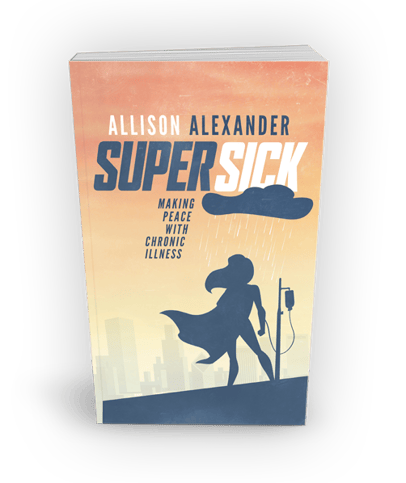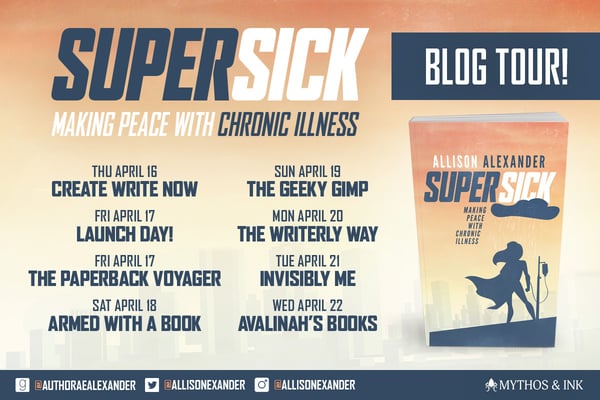Welcome to the blog tour for Super Sick: Making Peace with Chronic Illness! Each stop in the tour features a fictional character who experiences chronic pain or illness.
Often, when a book or movie represents a disability or illness, the entire thing is about that illness; think Forrest Gump or The Fault in Our Stars. These characters' identities are entirely swallowed up by their disabilities. In other shows, characters with illnesses are only there on the sidelines to "inspire" the protagonist, in the way that Tiny Tim’s only purpose in A Christmas Carol is to be pitied by Scrooge.
Writers have also excluded characters with disabilities from stories due to the idea that once you're disabled or chronically ill, you're done. You're no longer a hero until you have found a cure or have “overcome” your disability.
As someone with a chronic illness, I appreciate it when I see three-dimensional protagonists who have conditions and are learning to deal with them while taking part in a larger narrative—characters like Laura Roslin.
Laura Roslin is abruptly promoted from Secretary of Education to the President of the Twelve Colonies at the beginning of Battlestar Galactica. Throughout the show, she faces incredibly difficult decisions with calm and poise as cylons threaten to destroy the fleet of human survivors. On top of battling for the lives of humanity and the stress of survival, Laura has terminal breast cancer. She has to deal with exhaustion, pain, treatments, side effects, and knowing that she’s fighting for a future that she will not live long enough to see.
Perhaps, you’re thinking, “What a great role model! She must inspire and encourage everyone in the fleet!”
Ha. Ha. Well. If you’ve watched Battlestar Galactica, then you know that no one in the show is a great role model (except maybe Helo, but I digress). Every character is incredibly flawed, makes mistakes, and makes terrible decisions. Laura is no exception. Not everyone loves her. In fact, quite a few people hate her. She’s human. And that’s how characters with disabilities and illnesses should be portrayed: as human. (I mean, alien or cylon is fine, too.)
As the show goes on, Laura’s condition deteriorates but her determination does not. In her position, I would be tempted to give up the presidency and find a corner to curl up and be sick in, but Laura spends her time fighting for the other souls in the fleet. Laura’s cancer does not swallow up her identity. It doesn’t take over the story. It doesn’t define her. And this is why I love her character so much.
Do you struggle with chronic pain or illness, or do you know someone who does? What have you noticed about how fictional characters with these conditions are portrayed?
Super Sick: Making Peace with Chronic Illness is available on Amazon, Barnes & Noble, The Book Depository, and other major booksellers on April 17, 2020.
This is the first stop on my virtual tour, you can visit my other tour stops:
April 16: Create Write Now - Laura Roslin & Perseverance
April 17: Mythos & Ink - Launch Day Party on Facebook
April 17: The Paperback Voyager - Doctor House & Pain Management
April 18: Armed with a Book - Raven Reyes & Pressing On
April 19: The Geeky Gimp - Cloud Strife & Depression
April 20: The Writerly Way - Raoden & Chronic Pain
April 21: Invisibly Me - Wade Wilson & Shame
April 22: Avalinah’s Books - Jane Foster & Worthlessness

Bonus Content: Preview of Creating Characters with Disabilities, a free PDF Resource
Why is it important to include characters with disabilities and illnesses in our stories? For the same reason it’s crucial to feature characters of various races, sexes, genders, and minorities: because people want to see themselves in the stories they read and representation matters.
Contrary to popular practice, you do not need to write a book that entirely revolves around an illness or disability in order to include those characters. If that is the book you want to write, go for it, but don’t let your genre keep you from representing a wide variety of characters, including those who suffer from health problems. I’ve read about wonderful characters with illnesses in science fiction, fantasy, mystery, crime, fairy tales, action, drama, and more.
There are, however, a few traps that writers can fall into when creating characters with disabilities that do a disservice to these minorities. The purpose of this resource is to help you avoid them.
Disability Checklist
This is the checklist I go through when I encounter characters with disabilities in fiction. Ask these questions of your own writing to ensure you are doing your best to accurately represent these conditions and illnesses.
- Is the entire plot about the illness or disability?
There is nothing wrong with this, but you can include these characters in any genre and the story doesn’t have to revolve around their condition. There is an overabundance of this type of fiction in the market (think The Fault in Our Stars by John Green, My Sister’s Keeper by Jodi Picoult, or Me Before You by Jojo Moyes) because illness can be such a huge part of someone’s life. But, sometimes, those of us with chronic illnesses want to see ourselves represented in other stories and genres, in which our entire identities aren’t wrapped up in an illness. Maybe I want to see myself in a crime-fighting superhero who also just happens to have cancer instead of a wheelchair-bound teenager who can’t find love. (Dream on, you say? You obviously haven’t read The Mighty Thor).
- Is the character more than their disability?
Their illness should not define them. Yes, my illness is a big part of me, but I am not just a sick body. I have a personality. I have wishes, dreams, and goals. I have talents and flaws. I am more than my illness. Characters should be too.
- Does the character have a narrative purpose other than educating or in- spiring another character?
This is a common trope and not everyone understands why it’s a problem. Why shouldn’t your disabled character be inspiring to the other characters, after all? Inspiration Porn is a term coined by activist Stella Young, who had osteogenesis imperfecta.
“When people say you’re an inspiration, they mean it as a compliment,” she said during a TED Talk in 2014. “We’ve been sold this lie that disability makes you exceptional and it honestly doesn’t. … I want to live in a world where we don’t have such low expectations of disabled people that we are congratulated for getting out of bed and remembering our own names in the morning.”
I love the show Speechless because it makes fun of this tendency by showing how ridiculous it makes people with disabilities feel. In the pilot episode, one of the characters, J.J., is greeted with applause from his classmates when he enters his new school for no other reason than being in a wheelchair; he is even recommended for class president for the same reason. No one knows him, but they “don’t have to” because he’s an “inspiration.”
People with disabilities are just trying to live their lives like everyone else, and they do not exist to inspire others.
- Is the character cured or killed?
Often, writers overcome the “problem” of disability by curing it (magically or otherwise) or killing the character. It’s not that you can never kill a sick character, just don’t do it for pure dramatic effect or because you don’t know what else to do with them. There are so many great story opportunities you can take advantage of by portraying your character struggling with a condition rather than completely removing it. It may be tempting to include finding a cure as part of a quest because it feels unfair to leave a beloved hero in pain or disabled. It feels unfair to me, too, but I don’t get to drink a magic potion or wish away my illness. Consider how the story might work if their illness isn’t magically cured and they survive to tell the tale.
- Is the disability overcome?
Particularly in science fiction and fantasy, a character may have a disability that really isn’t a disability, such as being blind but being able to see just fine using magic. Sometimes, the only reason this disability is introduced is so the character looks “cooler” (or, in a villain’s case, “scarier”). Always consider how a character who actually has a disability would feel about their condition only existing for wow factor or to make a villain look ugly.
Read the rest of Creating Characters with Disabilities by signing up for Allison Alexander’s free newsletter.

Author bio: Allison Alexander is an earthbending Ravenclaw from Hoth who’s more comfortable curling up at home with a video game than venturing out into the wild. As an author, editor, and blogger, Allison aims to make spaces for minority characters in science fiction, fantasy, and pop culture. Also, her favourite character class in Dungeons & Dragons is a bard, so that should tell you everything you need to know about her.
From her home in Winnipeg, Manitoba, Canada—which she shares with her husband, Jordan—Allison writes books, edits novels, and mentors aspiring authors. Her book, Super Sick: Making Peace with Chronic Illness (Mythos & Ink) details her experiences with chronic illness and analyzes fictional characters who struggle with disabilities. She includes interviews with other chronic sufferers and explores how society values healthiness, doctors don’t always have answers, and faith, friendship, and romance add pressure to already complicated situations.
NOW ON SALE!



Leave Comment